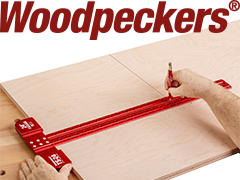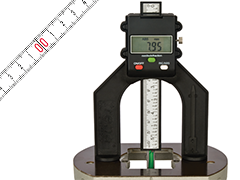- Measuring Tools
Measuring Tools
The importance of precise measuring and marking can hardly be overemphasised. For this, in turn, high-quality and precise tools are indispensable.
We offer you a wide selection of measuring tools from manufacturers whose names vouch for this high quality: T-squares, combination angles, marking gauges, measuring tapes, folding rules and calipers, protractors and bevels (some in digital versions) and marking-out rulers.
The marking tools of the US manufacturer Woodpeckers are famously high quality and very precise.
PRECISE MEASURING AND MARKING: THE BASIS OF ALL GOOD JOINERY WORK.
Careful measuring and marking gives the woodworker the confidence to cut workpieces precisely. Regarding the keyword 'precision', it should be noted at this point that it differs depending on the trade within woodworking. A carpenter, for example, will tend to measure and cut in the centimetre range, while carpenters, joiners and turners usually work to the millimetre, sometimes even measuring to within half a millimetre. However, fractions of a millimetre (tenths or even hundredths) are measurements that are more important in metalworking or precision engineering. Electronic measuring instruments that display such measurements can be useful for woodworkers because of their ease of use. Their use is most justifiable when setting the cutting height of machines (table saws and routers).
MEASURING AND VARIOUS MEASURING TOOLS
The most important traditional measuring tools of the carpenter are the folding rule, the ruler, the carpenter's square and the mitre gauge.. The folding rule is used to measure lengths between two metres and one millimetre, the square is used to check the squareness of edges and scribed lines, and the mitre gauge. is used to check the 45° and 135° angles that are important in woodworking. The carpenter's square and the mitre gauge are also used to mark out the measured angles. Due to its design, the folding ruler is not suitable for marking out a straight line. A ruler is used instead. In English-speaking countries, the combination square is widely used, which combines the functions of a ruler, carpenter's square and mitre rule and is also becoming increasingly popular in this country.
The following measuring tools are also useful for some woodwork:
- A protractor (in the form of a drafting triangle or as an electronic device) when working with angles that are not 45°, 90° or 135°.
- A caliper is mainly used when measuring the thickness of materials, with vernier, analogue scale or digital display, depending on personal preference.
- The tape measure (especially with lengths of more than two metres) is used, for example, in interior finishing. Some woodworkers also use the tape measure instead of the folding ruler in the workshop, depending on their personal preference.
- Self-adhesive measuring tapes with millimetre divisions attached to machines, router tables and jigs are time-saving and precise aids for accurately machining workpieces.
- Setting gauges for routers and circular saws allow you to quickly and accurately set the desired cutting or routing depth and pay for themselves very quickly if you work with these machines frequently.
SCORING AND MARKING
When working with hand tools, measuring is usually followed by scribing. When working with machines, scribing can often be omitted because of the machine's fences and attachments, since by setting the correct cutting dimension you have already ensured that the workpiece is machined as desired. However, when machining several workpieces, it is usually advisable to mark the off-cuts to avoid mistakes.
To score, you use a suitable tool to indicate the point to which the wood is to be cut. This is usually done with an appropriate pencil (most carpenters prefer pencils, such as those of the Pica brand) or a marking knife. For simple cracks, the knife or pencil is guided along a straight edge: a ruler, a joiner's square, a mitre gauge or a bevel. Straight lines that run parallel to a workpiece edge can be scribed quickly and precisely with a marking gauge or tenon marking gauge. Curved lines are a special case when scribing. They are scribed with a curve ruler, for example.






